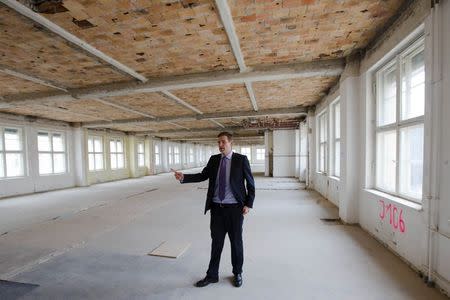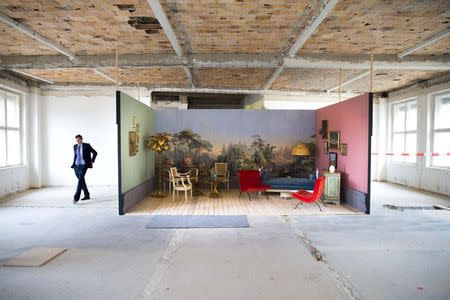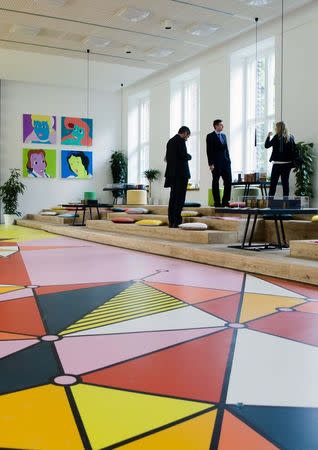Property along Berlin's former 'death strip' lures wealthy buyers
By Anja Nilsson BERLIN (Reuters) - When luxury living quarter The Garden opens next year only a metal strip across the courtyard retracing the Berlin Wall will remind its affluent inhabitants that 25 years ago this was the "death strip" on no man's land separating east and west. Instead of barbed wire and sentries, residents will be greeted by a 24/7 doorman and concierge service - and perhaps eventually, a growing, city-wide pushback against gentrification. On the anniversary of the fall of the Wall in 1989, Berlin is belatedly attracting the kind of wealth normally associated with the capital of a major economic power. A fluke of history means the city has a supply of vacant lots in coveted central locations along the Wall built by East Germany's communists to keep capitalism at bay, though some developers are wary of being too brazenly commercial about this. "Clients, international and German alike, value living on historical ground," said Michael Ries of the property developer Pantera which is behind The Garden project and is the German partner to Sotheby's International Realty. That same history has led to a less-than-linear growth path for Berlin's property market in the last quarter-century. "For the longest time, it was just not worth buying here. This changed once Germany and Berlin emerged as a safe business location and investment destination in the wake of the economic and financial crisis," said Nikolaus Ziegert, whose consultancy has a 17.5 percent slice of the luxury market. Economy Minister Wolfgang Schaeuble has warned of the danger of a German property price bubble and the central bank has said apartments in some urban locations are over-valued by up to 25 percent, but the financial watchdog sees no evidence of this and Berlin itself seems to be years away from any such risk. "Only if this price increase continues for years and years would we approach something close to a property bubble in Berlin," said Franz Eilers, head of research at the VDP mortgage bank association. Last year 220 luxury condominiums were sold in Berlin, up from 185 in previous years, according to a report by consultancy bulwiengesa for Ziegert. International clients now make up half of the buyers in the luxury market, said Ries. Dubbed the "epicenter of cool" and "Brooklyn on the Spree" river by the foreign press, Berlin is seeing economic growth to match its trendy reputation. Its output grew 1.7 percent in 2013, higher than the German national average. Compared to London, New York and Paris, the Berlin market is still in its infancy. An exclusive complex, like Ziegert's Lux, is rare. It is more common to have a few luxury flats rub shoulders with normally priced ones, as in Pantera's The Garden. SELLING POINT? Legal disputes are often behind the long delays in building along the Wall's route. Not all developers agree that the Cold War history is a valid selling point. Annette Mischler of the Groth Group sees it as "artificially resurrecting history" to put it in promotional material but Ries at Pantera said it would be to "ignore important history if we didn't". The Wall is not the only historical association on Berlin's luxury property market. Film enthusiasts can now buy one of 220 lofts in Ziegert's red-bricked Metropolis Park, named for the Fritz Lang movie masterpiece of 1927. The most expensive flat in the complex went for 1.3 million euros (1.75 million). The brochures did not mention its past role as the Karl Marx Academy where communist cadres were trained, though it does add to the "aura" of the building, the Ziegert consultancy's Schlueter said. Eva Maria Fallenberg, 42, a radiologist hunting for an apartment in Berlin, said such matters were "not a priority" in her search but she was drawn to the Metropolis complex's "rich history", though she decided against buying there. "I really liked the project's efforts to preserve and restore the exterior of the building, unlike projects by the Wall Park and the East Side Gallery," she said, referring to two of the tourist landmarks along the route of the Berlin Wall. A 600-apartment project by the Wall Park, a former border strip turned into a park with live music and a flea market that attract about 50,000 people each weekend, has locals up in arms - part of an anti-gentrification backlash in a city better known for squatters and struggling artists than plush condominiums. "The argument that they're helping the community by building much-needed new apartments is ridiculous," said Alexander Puell, a 39-year-old member of the Wall Park Friends Association. "Yes, we need a lot of new apartments, but there is no shortage of luxury apartments, what we need is socially responsible investment appropriate to this neighborhood," Puell said as he promoted recycling at a school near the Wall Park. The Groth Group, which owns the site, said the plan is for middle-class housing, but for locals like Puell luxury begins much lower than the official definition of 5,000 euros ($6,700)per square meter. Parallel protests against a luxury project at the East Side Gallery, a 1.3-km section of the Wall covered with paintings, suggest there is a "slowly crystallizing network of Berliners concerned about city development", Puell said. (Reporting by Anja Nilsson; Editing by Stephen Brown and Michael Roddy)




